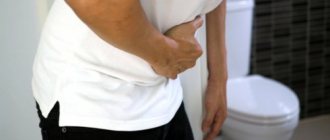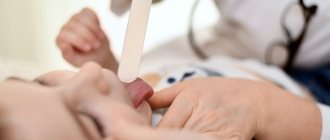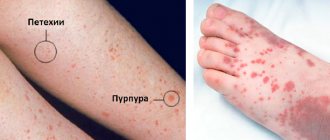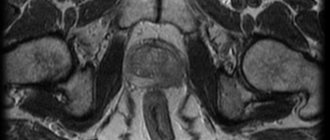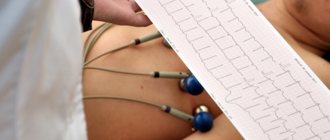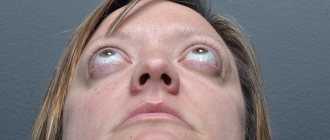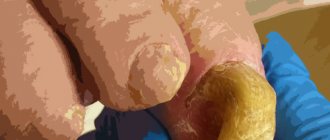Anal bleeding is a condition in which blood in any form is released from the anus. Blood loss of this kind is very rarely severe. Their relevance is associated not so much with the danger to life, but with the widespread prevalence and discomfort that arises when they appear.
But do not forget that anal bleeding is just a symptom. It often becomes the first manifestation of dangerous diseases of the large intestine and rectum. You can roughly determine the nature of bleeding from the anus by determining its features.
Causes of bleeding from the anus
If you notice blood on toilet paper after bowel movements, even if the process of bowel movement occurs without pain, you should definitely consult a proctologist for advice in order to establish the cause of the bleeding, start treatment in a timely manner and avoid possible complications.
Why does blood appear from the anus after stool in both men and women:
- A fairly common factor is hemorrhoids (enlargement of the veins of the rectum). Scarlet blood appears from the anus during defecation.
- Anal fissure is the second most common cause of rectal bleeding. The disease is characterized by a burning sensation during bowel movements, sometimes accompanied by acute pain (patients describe it as cutting and then squeezing). Bloody discharge appears in both small and copious portions.
- Inflammatory diseases of the colon.
- The presence of benign formations (polyps). A characteristic symptom is the discharge of blood from the rectum after defecation. The blood is darker, often with mucus.
- The presence of a malignant tumor of the rectum. Blood of different colors may be released. Quite often, the blood released does not differ in any way from the blood that is released, for example, from hemorrhoidal tissue. And if the presence of hemorrhoidal disease only worsens the quality of life (hemorrhoidal tissue never degenerates into a malignant tumor), then the presence of a benign formation or a malignant tumor can be harmful to health and life-threatening, which is why you should not try to independently determine the source.
Only a coloproctologist can determine the true cause of bleeding from the anus and select the appropriate treatment. Timely diagnosis allows for effective conservative and minimally invasive treatment.
Is rectal bleeding a reason to panic?
Despite the fact that there are no minor reasons that could provoke such a phenomenon, situations can still be different. Sometimes you can wait a few hours before the start of a new working day and go to see a doctor as usual, but sometimes the situation is urgent: you should call a doctor and often agree to hospitalization. Such situations are the following:
- Copious bleeding that cannot be stopped;
- Vomiting, with contents in which traces of blood are visible;
- Bloody discharge from the nasal passages;
- Detection of hematomas, bruises, the nature of which is not mechanical (bruise, blow, etc.);
- General deterioration in health: increased body temperature, abdominal pain.
If, after visiting the toilet, you find traces of blood on the paper, and one of the listed conditions is present, call an ambulance immediately. The appearance of rectal bleeding does not always mean an advanced disease. For example, with tumors of the digestive organs, it is the first symptom, but the color and amount of discharge will depend on the location of the tumor. It is also possible to detect blood almost immediately with intestinal diverticulosis, since this disease is characterized by protrusion of the walls.
Discharge color and disease
- bright red, scarlet blood from the anus on toilet paper or underwear, drops at the end of a bowel movement (stool) - hemorrhoids or anal fissure;
- red color of blood during anal bleeding - cancerous tumor, intestinal polyp;
- dark blood clots - tumors of the distal colon, diverticulosis;
- cherry-colored blood from the anus - pathology of the colon;
- black, tarry stools - diseases of the stomach, duodenum and small intestine.
IMPORTANT!
Bleeding is a serious symptom, after the appearance of which you cannot postpone a visit to the doctor. Unfortunately, blood from the anus can cause diseases such as a tumor of the rectum or colon. And in the worst case, this tumor may turn out to be malignant. Blood can also occur as a result of injury to a polyp - a benign tumor. Long-term polyposis can be a sign of colon cancer.
Treatment methods for hemorrhoids
Choosing toilet paper is an important issue!
In the treatment of hemorrhoids, patients should adhere to the following recommendations:
- avoid constipation, especially during the period of exacerbation of the disease and the occurrence of its complications (bleeding, inflammation of the hemorrhoid). The basis for this task should be a diet high in fiber and fluid. You need to try to develop a conditioned reflex to defecate at the same time and stimulate it with fluid intake. The duration of the act of defecation should not be too long to avoid increasing pressure in the intestines. If these simple measures do not have an effect, then laxatives should be used;
- conduct a daily course of local water procedures in the form of sitz baths for the anal area. They are carried out in the evening in cool water, which has a vasoconstrictor effect and stimulates blood supply to the anal area, or with chamomile decoction, which has disinfectant properties. The decoction is prepared from 4 tablespoons of chamomile flowers, poured into one liter of cold water, by bringing it to a boil and then cooling to room temperature;
- follow a diet that excludes spicy foods, coffee, strong tea, alcohol and includes in the diet a large amount of liquid (up to 2 liters per day) in the form of juices, fruit drinks, water, as well as foods rich in fiber, to form stool of a soft consistency and elastic structure; getting rid of excess weight, especially with fat deposits in the abdominal area, which is a factor that disrupts the venous outflow from the large intestine;
- strict adherence to general hygiene rules and the anal area in particular, which implies washing after each act of defecation with cool, clean water, which helps to narrow the blood vessels and normalize the tone of the vascular wall; exclude heavy lifting as a factor causing an increase in intra-abdominal and, accordingly, intra-intestinal pressure;
- Focus on moderate, non-strength exercise for the lower body. Walking, which stimulates venous outflow from the pelvic organs, as well as gymnastics and swimming have a particularly positive effect. It is recommended to do special gymnastics for the muscles of the anal area every 2 hours, alternately tensing and relaxing them 10-15 times, as well as performing circular movements of the pelvis and bending forward and backward;
- do not use tight-fitting underwear and trousers, so as not to disrupt the venous outflow from the pelvis;
- do not take a long hot bath or shower, which increases blood flow to the pelvis and reduces venous outflow from it.
Bleeding pattern and disease
- Regular heavy bleeding not associated with bowel movements - diverticulosis, polyposis, Crohn's disease, ulcerative colitis, rectal or colon cancer;
- Blood mixed with feces - cancer of the rectum and colon;
- Bleeding with diarrhea - dysbiosis, irritable bowel syndrome;
- Discharge of blood with mucus or pus - internal hemorrhoids, rectal prolapse or polyp;
- Severe bleeding with mucus - proctitis, colitis, rectal cancer.
Make an appointment
Crohn's disease
Crohn's disease is a severe inflammatory disease of all layers of the intestinal wall. In this case, nodules called granulomas appear inside the intestinal wall. The disease cannot be completely cured, only achieving remission. Crohn's disease affects all parts of the gastrointestinal tract. The mucous membrane becomes covered with ulcerative lesions, the ulcers can deepen, pseudopolyps are formed, polyps and ulcers alternate with each other. When the disease becomes more complicated, fever, bleeding, abscesses, fistulas, and peritonitis appear. Characterized by abdominal pain, flatulence, weight loss, anemia, hypovitaminosis. The disease develops slowly over several years. With Crohn's disease, symptoms such as damage to the joints, the mucous membrane of the eyes, and inflammation of the lymph nodes appear.
Diagnosis and treatment
When faced with an intimate problem, especially such as bleeding from the anus during bowel movements, you can get confused, especially if you don’t know about the methods of diagnosing and treating such ailments or don’t understand which doctor to contact.
A proctologist or coloproctologist is a doctor who diagnoses and treats diseases of the colon, rectum and anus, as well as problems of the sacrum, coccyx and perineum. You should not postpone a visit to this specialist if there is blood from the anus after stool.
A proctologist will listen to complaints and the history of their occurrence, and to determine the cause of the appearance of blood from the rectum, he may perform the following procedures:
Digital examination of the rectum: a primary research method that makes it possible to assess the condition of the anus and identify possible pathologies in the form of neoplasms, anal fissures, uncharacteristic discharge, and bleeding.
After a digital examination, the coloproctologist, if necessary, prescribes further diagnostic methods using special equipment:
- Anoscopy. This is an examination of the last 3-7 cm of the rectum; it is in this area that almost half of the sources of visible bleeding are located. There are several types of anoscopes (straight, conical, with and without a cutout, transparent and not transparent), each of them is used strictly according to indications, but any of these types allows you to perform a full examination of the anal canal and lower ampullary rectum. Anoscopy is used when performing minimally invasive methods of treating hemorrhoids (ligation, sclerotherapy), as well as performing a number of surgical interventions (bipolar coagulation). As a rule, no preparation is required to perform diagnostic anoscopy; preparation is required for anoscopy for therapeutic purposes.
- Sigmoidoscopy or rectoscopy (RRS or RRS) is a diagnostic procedure using a special device with a camera. It makes it possible at the initial appointment to quickly and painlessly visually assess the condition of the rectal mucosa, identify the presence of mucosal formations and compression of the intestine. During rectoscopy, up to 20 cm of the intestine is examined (the entire rectum and the place of its transition to the sigmoid). Preparation is required for rectoscopy.
- Colonoscopy is the most informative method of examining the large intestine compared to others. It is carried out using a flexible fiber colonoscope equipped with a high-resolution camera that will show even the smallest sources of bleeding. The procedure is also prescribed for the purpose of endoscopic removal of colon formations. A colonoscopy is performed by an endoscopist.
The appropriate method of treating the disease is determined and prescribed by the doctor. You should not engage in self-treatment and neglect contacting a coloproctologist.
What kind of help should there be?
The appearance of any variants of anal bleeding is subject to detailed analysis and diagnosis of the cause of its occurrence. This applies not only to acute cases of new bleeding, but also to those types of bleeding that have been observed in people for a long time. You can’t interpret everything as chronic hemorrhoids. After all, no one is immune from the occurrence of tumors. Rather, on the contrary, persons with chronic pathology of the rectum and anal canal, first of all, should be examined, since they constitute a risk group. In life, things don't happen quite like that. Only those who experience anal bleeding for the first time immediately seek help. Patients with chronic rectal bleeding do not always do this.
The main measure of assistance, regardless of its cause, should be a thorough diagnosis. This is, first of all, an examination of the rectum and colon. They include:
- Finger examination;
- Sigmoidoscopy (examination of the rectum and initial part of the sigmoid colon with a rigid device);
- Fibercolonoscopy (examination of the entire large intestine with a flexible endoscope);
- Irrigography – an X-ray examination of the large intestine by filling it with contrast followed by photographs;
- A clinical blood test is required to determine the level of hemoglobin, red blood cells and hematocrit number.
Treatment of anal bleeding is a relative matter. Indeed, if they occur as a symptom, it is necessary to diagnose the causative disease. Only by eliminating it can you get rid of the bleeding. The only exceptions are profuse bleeding with large blood loss, the treatment of which becomes an emergency measure. It could be like this:
- For bleeding hemorrhoids - venotonic tablets (venodiol, detralex, phlebodia, normoven), preferably in high single doses. Suppositories and ointments are required (procto-glivenol, ultraproct, proctosedyl, proctosan). Continued bleeding is an indication for packing the anal canal with gauze pads soaked in aminocaproic acid or hydrogen peroxide. If these measures do not help stop the bleeding, surgical treatment is indicated (stitching or removal of bleeding hemorrhoids);
- For disintegrating tumors, colon and rectal polyps with bleeding, infusion therapy with hemostatic drugs (etamsylate, vikasol, aminocaproic acid) is indicated. If there is no effect, attempts must be made to endoscopically stop the bleeding by identifying the source and cauterizing it. In extreme cases, surgical treatment is performed;
- Bleeding in inflammatory bowel diseases is very rarely active. Usually, they do not require specific measures to stop them. Treatment of the underlying disease leads to a reduction in anal bleeding.
A gentle regimen is indicated for all patients with this pathology. In case of massive profuse bleeding, it should be done in bed. The diet involves the exclusion of spicy foods, alcohol, smoked foods, and in case of severe bleeding, food is completely prohibited.
Anal bleeding is the tip of the iceberg of the disease. Don’t forget about this when dealing only with stopping it. Treating the cause is the only correct way to eliminate it.
How to prepare for the examination?
The own research of specialists from the proctology department of the Altermed clinic made it possible to make a visit to a proctologist as easy and comfortable as possible. There is no longer any need to fast the day before and plan the procedure for the morning. In the proctology departments of Altermed, a way has been found to successfully cope with all these difficulties. This is Microlax bowel preparation.
The use of Microlax microenemas makes fasting unnecessary, does not require special equipment or premises, and saves a lot of time. The laxative effect occurs 5-15 minutes after administration of the drug. The quality of bowel cleansing is such that treatment can begin immediately after rectoscopy and anoscopy. If it is necessary to use during pregnancy and lactation, Microlax does not require special precautions.
The Proctology Clinic provides diagnostics using the most modern equipment. The best doctors in St. Petersburg - both men and women - and a delicate approach are at your service.
Helminthiasis
Infection with helminths is another possible cause of light bleeding from the anus. Signs of helminthic infestation may be mild, so you must be attentive to any existing symptoms. It can be:
- itching in the anus;
- redness of the skin of the anus and genitals;
- weight loss;
- constant headaches.
When infected with worms, the patient loses his appetite, he develops signs of general intoxication: drowsiness, lethargy, decreased performance. The temperature may remain within normal limits or rise to low-grade fever. A rise above 38° rarely occurs - only in the case of extensive damage to internal organs by mixed forms of parasitic infections.
Bleeding from helminthiasis is not profuse and not painful. Blood may cover or be mixed with the stool.
Treatment of helminthic infestation
To destroy worms in adults and children, anthelmintic drugs based on levamisole or mebendazole are used: “ Dekaris
", "
Vermox
", "
Pyrantel
". "Pyrantel" in most cases is the drug of choice, as it can be used for the treatment of mixed helminthic infestations. Children can be given the product in the form of a sweet suspension (5-10 ml once). For adults, the drug is available in the form of tablets, which must be chewed thoroughly with a sufficient amount of water. The dosage for adults is 3 tablets. If the patient's weight exceeds 75 kg, the dose is increased to 4 tablets.
The drug is taken once after a meal. To exclude self-infection and prevent secondary infection, the medication must be taken again after 3 weeks.
Most common reasons
Haemorrhoids
Main article: Hemorrhoids: symptoms and treatment
About 10% of people in the middle age group suffer from hemorrhoids; men are affected 4 times more often.
Its development is facilitated by a sedentary lifestyle, heavy physical labor, and pregnancy.
At the beginning of the disease, there is discomfort and a sensation of a foreign body in the anus. Recurrent rectal bleeding then appears. They occur during defecation or immediately after it. The blood has a bright red color; it does not mix with the feces, but covers it on top. Traces of blood may be found on toilet paper and underwear. The volume of blood released varies from a few drops to a puddle. Frequent intense bleeding leads to the development of anemia.
Be sure to read:
Mucus in a child’s stool: causes and what to do?
When inflammation occurs, pain occurs during defecation and persists for some time after it.
Mucus discharge irritates the skin around the anus, causing an itchy sensation, and contributes to the development of eczema.
Anal fissure
Main article: Rectal fissure
It is a linear ulcer located in the lower part of the anal canal.
Its main symptoms are bleeding and pain that occurs during bowel movements. The pain is quite intense, burning, stabbing in nature, radiating to the perineum, sacrum, and rectum. It lasts from several minutes to several hours.
Bleeding is usually minor. In this case, the blood is on the surface of the stool in the form of stripes and does not mix with it. Sometimes blood comes out in drops at the end of a bowel movement, leaving marks on paper or underwear.
Polyposis of the colon
Polyps are benign neoplasms of epithelial nature.
They can be single or multiple, localized in any part of the colon, and are prone to degeneration into malignant tumors. The main complaints of patients with polyposis are:
- discomfort;
- abdominal pain that does not have a clear localization;
- bowel dysfunction in the form of alternating constipation with diarrhea;
- stool mixed with mucus and blood.
Bleeding with polyposis is not intense. The blood is dark, mixed with mucus and feces, however, the closer to the anus the polyp is located, the brighter the blood. Bleeding can also be hidden, and quickly leads to anemia in the patient.
Colorectal cancer
Main article: Colorectal cancer: symptoms and treatment
Tumors of the large intestine begin to manifest themselves only after 1.5-2 years from the moment of their occurrence. Bleeding is a delayed symptom and develops at the stage of tumor disintegration.
The first signs of rectosigmoid cancer are spastic constipation, the stool becomes ribbon-shaped, and later mucus and blood appear on its surface. Often with intestinal cancer, hemorrhoids develop, which are extremely difficult to treat. Pain is not typical for this location and appears only with the development of intestinal obstruction. The tumor may not be detected by palpation even in the late stages of the disease.
When a tumor affects the right parts of the colon, the first symptoms appear very late and are nonspecific. Signs of intoxication increase (fever, accelerated ESR), lack of appetite, rapid loss of body weight. Pathological impurities appear in the stool: mucus, blood (usually hidden), pus, and sometimes the stool takes on the appearance of “raspberry jelly.” Later, pain appears in the right half of the abdomen, and the tumor is often detected by palpation.
Be sure to read:
Consistency of stool in an adult: where is the norm and where is the pathology?
Rectal cancer is characterized by nagging, burning pain in the rectum, frequent urge to defecate, followed by the release of mucus and blood. Blood does not mix with feces, but unlike hemorrhoids, it is released at the beginning of defecation. Feces may include pus and tumor breakdown products.
Diverticular disease
Diverticulosis in most cases affects the large intestine, mainly its left sections. The incidence of the disease increases with age, affecting more than 60% of the population after 70 years of age.
Uncomplicated colonic diverticulosis is usually asymptomatic. Inflammation of the diverticulum manifests itself:
- pain predominantly in the left abdomen;
- unstable stool;
- decreased appetite;
- nausea;
- increased temperature;
- leukocytosis.
Diverticulitis is complicated by bleeding in 3-5% of patients. It is often profuse and develops suddenly. Signs of acute blood loss increase (weakness, pale skin, dizziness, tachycardia), and little changed blood appears in the stool.
Nonspecific ulcerative colitis and Crohn's disease
Main articles: Ulcerative colitis and Crohn's disease
Inflammatory bowel diseases with similar intestinal manifestations. They are characterized by an undulating course with periods of exacerbation and remission.
The main symptoms of the disease are:
- bloody diarrhea;
- abdominal pain;
- fever during exacerbations.
With nonspecific ulcerative colitis, diarrhea with blood can be the only symptom of the disease for a long time. With Crohn's disease, bleeding occurs less frequently; depending on the level of damage, blood in the stool may be detected in the form of dark clots or bright red streaks.
In addition to intestinal damage, there are systemic symptoms (erythema nodosum, arthritis, skin and eye damage, sclerosing cholangitis, etc.)
Intestinal and other infections
Main article: Intestinal infections: symptoms and treatment
Anal bleeding is sometimes a symptom of certain infectious diseases (dysentery, typhoid fever, amoebiasis, hemorrhagic fevers).
Infectious diseases are characterized by:
- acute onset;
- febrile fever;
- weakness;
- headache, muscle pain;
- and other manifestations of intoxication: vomiting, diarrhea, severe abdominal pain.
In this case, abdominal pain always precedes bleeding. The blood is usually dark and mixed with stool and mucus.
Pseudomembranous colitis
Main article: Pseudomembranous colitis
One of the dangerous complications of antibiotic therapy. Most often it develops while taking sulfonamides, clindamycin, ampicillin, lincomycin, and cephalosporin drugs.
The disease manifests itself as cramping abdominal pain, intoxication syndrome, and severe diarrhea. The stool is copious, watery, and in severe forms it takes on the appearance of “rice water.” The stool contains pathological impurities - mucus, blood.
Nutrition for bleeding during bowel movements
If a person experiences the above symptoms, serious changes should be made to their diet:
- observe drinking regime;
- consume fermented milk products;
- increase the amount of cereals in the diet;
- give preference to black bread.
If constipation occurs, eat foods with a mild laxative effect:
- salads with beets;
- use pumpkin seeds in recipes;
- carrot salads;
- prunes and dried fruit compotes.
Treatment with traditional medicine
Many people wonder: how to get rid of hemorrhoidal bleeding at home? The initial stage of hemorrhoids is treated with traditional methods, so this approach is quite natural.
Healers achieve high efficiency in treating an unpleasant problem, practically guaranteeing a positive result from this approach. However, it is quite risky to use traditional methods without the supervision of a competent specialist.
It is better to use healers’ recipes as aids in professional therapy prescribed by a doctor.
The most popular folk methods are presented by the following recommendations:
- taking baths with a small amount of potassium permanganate solution for hemorrhoids;
- baths with the addition of infusion of chamomile and St. John's wort, mixed in a ratio of 1 to 1, in case of anal fissures;
- the use of microenemas with chamomile (30g of chamomile flower herb, brew with a glass of boiling water, cool, leave for 2 hours, insert into the anus using an Esmarch mug) for colitis, fissures, hemorrhoidal internal manifestations;
- if the patient has helminths, they are removed using a solution from onions: a chopped onion head is poured with warm boiled water overnight, filtered in the morning and the liquid is drunk on an empty stomach;
- you can get rid of tapeworm using the simplest available products - garlic and milk: you need to eat 10 heads of garlic and drink a glass of milk, and then, after 40 minutes, take a laxative (however, this method is not suitable for everyone);
- the use of tampons moistened with sea buckthorn oil (sea buckthorn is an effective anti-inflammatory and hemostatic agent) as lotions to the anus;
- to combat polyps in the intestines, use celandine: a decoction of the herb is used for enemas, and the infusion (1 to 4) is drunk 10-15 minutes before meals, in the morning;
- horseradish roots mixed with honey (1 to 1), take a teaspoon three times a day - also to eliminate polyps;
- orange peel boiled in boiling water will serve as an excellent remedy against bleeding: you can either eat the peel of the fruit or add sugar to the broth and drink in small portions, 3 times a day;
- A well-known hemostatic agent, nettle, will help stop severe bleeding: dry herb (30 g) should be brewed with boiling water (200 ml), cooled and taken three times a day, 1 tbsp. spoon, before eating.
To effectively eliminate bleeding, ice suppositories are often used, prepared in this way:
- Having twisted the paper into a cone, you need to pour herbal infusion or cooled, after boiling, water into it;
- place the cone in the freezer;
- after freezing, insert into the anus, being careful.
This method is good in cases where the patient does not have an inflammatory process. If there is one, such procedures are strictly prohibited.
Herbs for back bleeding
If the bleeding does not stop on its own after bowel movement, it is recommended to use chilled herbal infusions, introducing them into the rectum using an Esmarch mug.
The following fees have proven themselves to be excellent:
- Pour 20 g of chamomile (flowers) with boiling water (1 glass), leave for at least 5 hours, apply after straining;
- Pour 50 g of yarrow into 0.5 liters of boiling water, leave for 2-3 hours, cool (this plant has an astringent effect and perfectly eliminates bacterial infections).
It is important to remember: self-medication can be dangerous; medications should be selected by a doctor individually, since they are not suitable for everyone and not always.
Bleeding may be false
The discharge of blood in feces may well be a false manifestation associated with the consumption of certain foods.
In this regard, you should not panic as soon as you notice changes in the color of your stool. You should remember what foods a person ate.
It is possible that changes in diet caused the stool to turn an unexpected color.
However, if after a few days the picture remains the same, you should sound the alarm - after all, an admixture of blood in the stool is always an unfavorable symptom.
Before visiting a specialist, self-diagnosis is recommended (which in no case replaces a medical examination).
